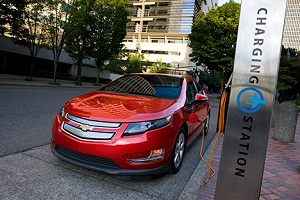EV charging stations to grow to $1.2 billion market by 2020
 Currently electronic vehicles (EVs) only make up a small portion of transportation on the road. But as it increases so will the volume EV chargers. In fact, a new Lux Research report finds that the EV charger market will grow from $140 million in 2012 to $1.15 billion by 2020.
Currently electronic vehicles (EVs) only make up a small portion of transportation on the road. But as it increases so will the volume EV chargers. In fact, a new Lux Research report finds that the EV charger market will grow from $140 million in 2012 to $1.15 billion by 2020.
While solar charging EV stations are quickly becoming popular, they’re still going to a small portion of the overall charger market, according to Lux Research Senior Analyst Kevin See, lead author of the report: Charging Ahead: Finding Reality in the Electric Vehicle Supply Equipment Market.
“Solar-powered charging is really small niche, and our view point is though it may appear in some places, it generally makes an expensive technology even more uneconomical,” See said. “It’s unlikely that solar generation will be able to provide a meaningful amount of energy for plug-in vehicles, particularly those with large batteries. In some select regions, with a large canopy and multiple chargers, solar could certainly supply a decent fraction of charging energy, but to take advantage of off-peak charging with solar you’d need to add a battery to the station which would add even more expense, making it difficult to find reasonable pay back periods,” he said.
The report largely looked at charging technologies like level 1, 2 and DC fast charging technologies, and by application, i.e., residential, work or public installations. Standardization of charging will be a key factor in the industry. “Standards are critical because varying standards require automakers to make vehicles with different capabilities, which adds cost to an already costly vehicle. Right now the big question has been around fast charging, where the CHAdeMO and the SAE combo chargers are out there, but the SAE standard appears to be gaining traction,” See said.
Vehicle and utilities should work together to develop common charging standards. See contended that the multiple standards and proprietary standard like Tesla’s specialty chargers for its Model S vehicles, ultimately hurt adoption of EVs and chargers, by providing another obstacle to wide-spread adoption. “Tesla is just looking to maximize a passionate customer base by making them buy chargers specially (call it an “Apple” like strategy) but in my opinion it only adds another obstacle. Tesla has big enough problems just trying to deliver vehicles on time that work like they are supposed to,” he said.
The growth in EV chargers will continue even though there is expected be slow adoption of plug-in electric vehicles across the world. Ultimately more chargers than EVs will be sold, according to See. “We are projecting that there will be more chargers than EVs; this follows naturally from the fact that on average there will be one level 1 charger sold with each vehicle (with some exceptions) and then public, work and commercial stations would add to that, resulting in greater than 1 station per vehicle.” The report anticipated that sales of EV chargers will increase from 120,000 units in 2012 to 1.3 million in 2020, rising at an annual growth rate of 30 percent.
The report found that Europe is likely to lead the global market of EV chargers by 2020, with anticipated sales of 480,000 annual sales by 2020. It will likely be followed by China, which could have annual sales of 277,000 charging units by then.
Still its unlikely adoption of EV chargers will be widespread enough to have EV highways anytime soon. “You will see more charging in public, but the roll out is going to be slow because there just is not the adoption of vehicles that is needed to drive fast growth,” See said. “Fast charging is really what would enable longer trips, and right now many cars do not even have that capability, and the stations themselves are exorbitantly expensive. This is one reason why we see public charging market as much smaller than residential charging, where most charging will take place,” he said.



